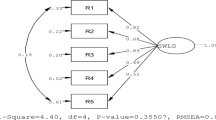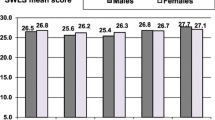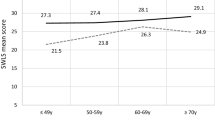Abstract
The life satisfaction questionnaire (LSQ) was developed for use in conventional and complementary/anthroposophic care to assess the quality of life/life satisfaction of Swedish women with breast cancer. The first attempt to test the reliability and validity was in a sample of women with breast cancer (n = 362), the second in a random sample of Swedish women (n = 257). A theoretical model with six latent and 34 manifest variables was formulated. The aim of the present study was to perform confirmatory factor analyses using structural equation modelling. The software STREAMS was used. An additional sample of men (n = 263) was randomly selected from the Swedish population register. Confirmatory factor analyses were performed for the combined sample of women and men (n = 520) and for the women with breast cancer. The result of the confirmatory factor analyses showed that the factor structure of the original model was confirmed. The factors were called physical symptoms (PS), sickness impact (SI), quality of everyday activities (QDA), socio-economic situation (SES), quality of family relation (QFA), and quality of close friend relationship (QFR).
Similar content being viewed by others
References
Anderson RT, Aaronson NK, Wilkin D. Critical review of the international assessments of health-related quality of life. Qual Life Res 1993; 2: 369-395.
Smith K, Avis N, Assman S. Distinguishing between quality of life and health status in quality of life research: A meta-analysis. Qual Life Res 1999; 8: 447-459.
Carlsson M, Hamrin E. Psychological and psychosocial aspects of breast cancer and breast cancer treatment. A literature review. Cancer Nurs 1994; 17(5): 418-428.
Hamrin E. Utvärdering av komplementär vårdform vid bröstcancer. In: Wredling E et al. (eds), Omvårdnad Nu. 6:e konferensen The State of the Art in Nursing. [Evaluation of complementary care in breast cancer. In: Wredling R et al. (eds) Omvårdnad Nu. 6th Conference The State of Art in Nursing. In Swedish] Stockholm: Hälso-och sjukvårdens utvecklingsinstitut (Spri) och Svensk sjuksköterskefo ¨ rening (SSF), 1999: 29-37.
Carlsson M, Hamrin E. Measurement of quality of life in women with breast cancer. Development of a Life Satisfaction Questionnaire (LSQ-32) and a comparison with the EORTC QLQ-C30. Qual Life Res 1996; 5: 165-174.
Hamrin E, Carlsson M, Häggmark C, Langius A, Wahlström A. Utvärdering av bröstcancerpatienters livssituation utifrån olika vårdperspektiv. Rapport från förstudier. [Evaluation of the life situation among breast cancer patients from different care perspectives. Report from prestudies. In Swedish, with English summary]. Linköping: Omvårdnads-forskning vid Hälsouniversitetet i Linköping; No 9/1996.
Gorsuch R. Factor Analysis. New Jersey: Lawrence Erlbaum Associates, 1983.
Aaronson NK, Ahmedzai S, Bergman B, et al. for the EORTC Study Group on Quality of Life. The European Organization for Research and Treatment of Cancer QLQC30: A quality of life instrument for use in international clinical trials in oncology. J Nat Cancer Inst 1993; 85(5): 365-375.
Fayers P, Aaronson N, Bjordal K, Curran D, Groenvold M. Scoring Manual. Brussels: EORTC Quality of Life Study Group; 1999. (http://www.eortc.be/home/qol/manuals.htm).
Carlsson M, Hamrin E, Lindqvist R. Psychometric assessment of the Life Satisfaction Questionnaire (LSQ) and a comparison of a randomised sample of Swedish women and those suffering from breast cancer. Qual Life Res 1999; 8: 245-253.
Ullman JB. Structural Equation Modelling. In: Tabachnick BG, Fidell LS. (eds), Using Multivariate Statistics 3rd ed., New York: Harper Collins College Publisher, 1996: 709-811.
Larsson G, Larsson Wilde B, Munck I. Refinement of the questionnaire 'Quality of Care from the Patient's Perspective' using Structural Equation Modelling. Scand J Caring Sci 1998; 12: 111-118.
Carlsson M, Hamrin E. Life Satisfaction Questionnaire (LSQ). Manual. Uppsala: Department of Public Health and Caring Sciences, Uppsala University, 2000; and Linköping: Department of Medicine and Care, Linköping University, 2000.
Statistics Sweden, 1998. Official Swedish Statistics.
Gustafsson JE, Stahl PA. Streams. User's Guide. Version 2.5 for Windows 95/98/NT/, Gothenburg: Multivariate Ware, 2000.
Arbuckley JL. Amos User Guide. Version 4.01 Chicago (IL): Small Waters Corporation, 1999.
Cronbach LJ. Coefficient alpha and the internal structure of test. Psychometrika 1951; 16: 297-334.
Author information
Authors and Affiliations
Corresponding author
Rights and permissions
About this article
Cite this article
Carlsson, M., Hamrin, E. Evaluation of the life satisfaction questionnaire (LSQ) using structural equation modelling (SEM). Qual Life Res 11, 415–426 (2002). https://doi.org/10.1023/A:1015670628990
Issue Date:
DOI: https://doi.org/10.1023/A:1015670628990




